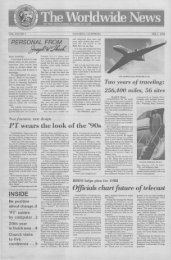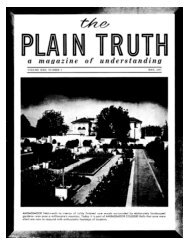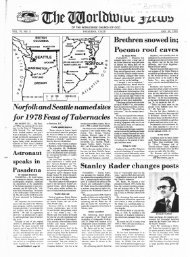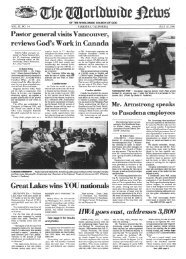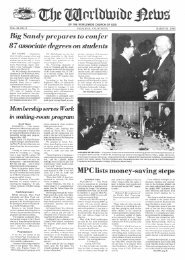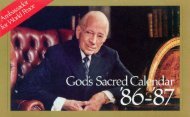The Biblical Basis of the Sacred Calendar Part One
The Biblical Basis of the Sacred Calendar Part One
The Biblical Basis of the Sacred Calendar Part One
Create successful ePaper yourself
Turn your PDF publications into a flip-book with our unique Google optimized e-Paper software.
Genesis 1:3-5 and o<strong>the</strong>r passages.<br />
Noon, Sunset and <strong>Calendar</strong> Days<br />
<strong>The</strong> timing <strong>of</strong> <strong>the</strong> molad is reckoned according to <strong>the</strong> equatorial day, in which <strong>the</strong> length <strong>of</strong> day and night<br />
is always equal (cf. Judaica, columns 44 and 46). This makes perfect sense on a round earth (with or<br />
without a tilted axis, if one raises this issue regarding <strong>the</strong> world before <strong>the</strong> Flood).<br />
It is only an assumption, however, that <strong>the</strong> Hebrew calendar reckons <strong>the</strong> molad in terms <strong>of</strong> Jerusalem<br />
time (loc. cit.). <strong>The</strong> medieval Jewish sage Maimonides assumed this, based on Isaiah 2:3: "...for out <strong>of</strong><br />
Zion shall go forth <strong>the</strong> law, and <strong>the</strong> word <strong>of</strong> <strong>the</strong> LORD from Jerusalem." In effect, he was stating that <strong>the</strong><br />
calendar day (for purposes <strong>of</strong> calculation) begins at Jerusalem, not east or west <strong>of</strong> it. But he was not<br />
stating an ancient tradition, but attempting to account for one.<br />
Jerusalem's location at or near <strong>the</strong> "navel [geographical center] <strong>of</strong> <strong>the</strong> earth" (Ezekiel 38:12) makes it an<br />
ideal center for God's future worldwide government and Work. It is not, however, ideally located as a<br />
referent for worldwide (as opposed to local) time-keeping. Its longitude is too far west to mark ei<strong>the</strong>r an<br />
"international date line" (IDL) or a meridian six hours west <strong>of</strong> an IDL (from which noon may be measured<br />
for calendrical purposes). It is also too far east to mark <strong>the</strong> "prime meridian" (PM), which now passes<br />
through Greenwich, England. <strong>The</strong> easternmost "end <strong>of</strong> <strong>the</strong> earth" (i.e., <strong>of</strong> <strong>the</strong> earth's land masses) is not<br />
at Jerusalem, but many thousands <strong>of</strong> miles east <strong>of</strong> it. Logically, <strong>the</strong> calendar day (as marked by an IDL)<br />
should begin <strong>the</strong>re - not at a city west (even in antiquity) <strong>of</strong> a considerable majority <strong>of</strong> <strong>the</strong> earth's human<br />
inhabitants.<br />
Thus a sacred calendar based on Jerusalem time (in which <strong>the</strong> calendar day begins at Jerusalem) ra<strong>the</strong>r<br />
than world time (in which <strong>the</strong> calendar day begins at an IDL) is by necessity a local calendar - and<br />
<strong>the</strong>refore truly useful only for Jerusalem and its environs. Since God intended from <strong>the</strong> beginning that all<br />
humans everywhere keep His Festivals (cf. Acts 15:18, KJV), let us take <strong>the</strong> simplest possible<br />
assumptions (based on what God reveals to us about Creation Week) and see where <strong>the</strong>y lead us.30<br />
First, we see from Genesis 1:3-5 that God based <strong>the</strong> lunisolar calendar on world time, not local time --<br />
which implies an IDL east <strong>of</strong> Jerusalem, "<strong>the</strong> navel <strong>of</strong> <strong>the</strong> earth". Next, He started <strong>the</strong> calendar's daily and<br />
weekly cycles on Day <strong>One</strong> <strong>of</strong> Creation Week, and <strong>the</strong> monthly, seasonal and solar cycles on Day Four.<br />
Fur<strong>the</strong>r, Day Four likely would have marked <strong>the</strong> fall (not <strong>the</strong> spring) equinox, making <strong>the</strong> season fall in <strong>the</strong><br />
Nor<strong>the</strong>rn Hemisphere and days and nights equal all over <strong>the</strong> earth. (We assume <strong>the</strong> season was fall<br />
because God created seed-bearing plants and trees on Day Three.31) Next, when God separated light<br />
from darkness (1:3-5), <strong>the</strong> eastern half <strong>of</strong> <strong>the</strong> terminator (<strong>the</strong> boundary between day and night) would<br />
have fallen on <strong>the</strong> meridian just east <strong>of</strong> <strong>the</strong> easternmost "end <strong>of</strong> <strong>the</strong> earth". This meridian would have<br />
marked <strong>the</strong> IDL, <strong>the</strong> basis <strong>of</strong> world time. (<strong>The</strong> location <strong>of</strong> <strong>the</strong> IDL, <strong>of</strong> course, has been adjusted in modern<br />
times for <strong>the</strong> benefit <strong>of</strong> <strong>the</strong> earth's inhabitants.) <strong>The</strong> western half <strong>of</strong> <strong>the</strong> terminator, by contrast, would have<br />
falled on <strong>the</strong> "prime meridian" or PM (180 degrees or 12 hours west <strong>of</strong> <strong>the</strong> IDL). Finally (and this is most<br />
important), <strong>the</strong> narrator <strong>of</strong> Genesis 1 would have described events using <strong>the</strong> language <strong>of</strong> appearance,<br />
and as <strong>the</strong>y would have appeared at <strong>the</strong> prime meridian.<br />
Let us now go back in time to Genesis 1:3-5. At <strong>the</strong> terminator, <strong>the</strong> first calendar day (Day <strong>One</strong>, Year<br />
<strong>One</strong>) now begins (verse 4). (Let us assume for argument's sake that <strong>the</strong> IDL is at our present 180<br />
degrees longitude.) It is now sunset at <strong>the</strong> eastern "end <strong>of</strong> <strong>the</strong> earth" (modern Siberia). Ninety degrees <strong>of</strong><br />
longitude west <strong>of</strong> <strong>the</strong> terminator (in modern Afghanistan), <strong>the</strong> local time is now 12:00 noon on Day Zero <strong>of</strong><br />
<strong>the</strong> calendar. At <strong>the</strong> PM (i.e., at <strong>the</strong> meridian passing through modern Greenwich, England, where <strong>the</strong><br />
narrator's viewpoint actually is), <strong>the</strong> local time is now 6:00 a.m. on Day Zero <strong>of</strong> <strong>the</strong> calendar. (Do not be<br />
confused by this. It is simply a matter <strong>of</strong> how one counts <strong>the</strong> days on a round earth.)<br />
"And it came to be evening, and it came to be morning: Day <strong>One</strong>" (verse 5, literal Hebrew). In o<strong>the</strong>r






